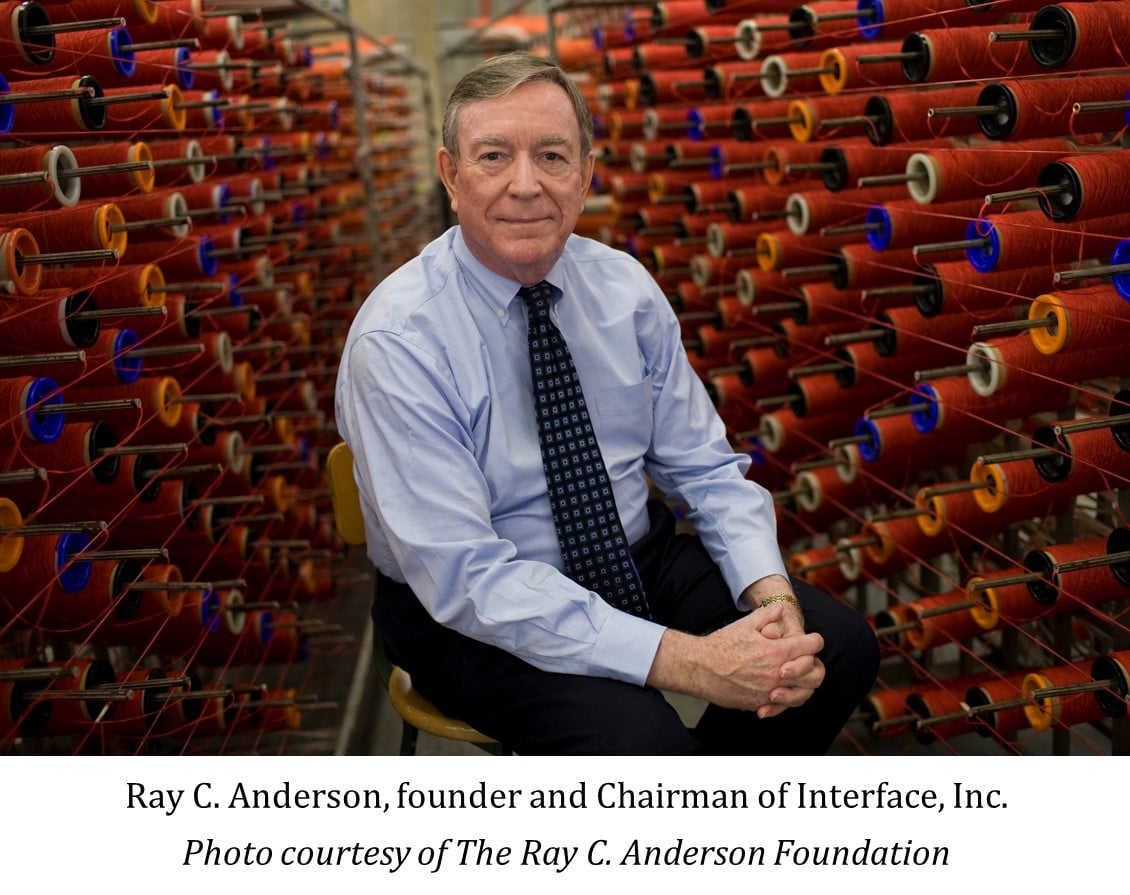How Thought Leadership Content Can Preserve a Legacy, Advance a Mission, and Elevate a Brand
June 22, 2021
Thought leadership content is educational and inspirational. It’s about a story, a mission, a goal.
Interface, Inc., a global commercial flooring company with an integrated collection of carpet tiles and resilient flooring, has all three. The story is about its founder, Ray Anderson, and its mission and goals are a part of his story.

The company’s website and its social media content provide a myriad of examples of thought leadership content and content marketing.
As you look at their site and social media accounts, the difference between the two will become clear. And you’ll see how thought leadership content can preserve a legacy, advance a mission, and elevate a brand.
Note: The Writers For Hire is in no way affiliated with Interface, Inc. and does not create its marketing copy. Interface, Inc. is spotlighted here solely as an example of thought leadership and thought leadership content.
First, the Story
In 1994, Ray Anderson was a highly successful entrepreneur. Within a 20-year span, he had become a millionaire—the Chairman and founder of a publicly traded company.
These accomplishments had been realized with the help of a few investors and a singular focus—popularizing the manufacturing technology for making carpet tiles.
Ray foresaw the growth of open plan offices with the constant need for spaces to be rearranged.
Unlike broadloom carpet, carpet tiles could be used over flat wire electrical cable and provide the interface between the systems furniture (a modular furniture solution that provides the various parts needed to create workstations) and the electrical outlets.
Carpet tiles met the electrical code restrictions associated with flat wire installations. Carpet tiles also filled a particular commercial design need. Like pixels, carpet tiles create endless design opportunities.

As a result of Ray’s initial entrepreneurial instinct to focus on carpet tile and the company’s expansion into additional successful flooring solutions, Interface, Inc. (Interface) is the one of the top five companies in the U.S. carpet mills industry (IBISWorld Industry Research Reports). Its global operations include seven manufacturing facilities on four continents.
Despite COVID-19’s negative impact on office space expansion and redesign, the company reported net sales of $1.1 billion in 2020.
But that’s getting ahead.
A 27-Year Look-Back
Interface’s current president and CEO, Dan Hendrix, graciously provided his insights into the company’s history, its founder, and its current mission. His affiliation with Interface began in 1977 as a member of its audit team, and he joined Interface as an employee in 1983.

When asked to describe Ray Anderson, Dan used the words “genuine, authentic, smart, charismatic, and competitive.”
He described Ray as an engineer who was a big thinker, but he seemed to sum him up by calling him a Southern gentleman—something that Wall Street investors seemed to love about him. He described Ray’s leadership style as collaborative and inclusive.
In 1994, a customer asked Ray what Interface was doing for the environment. The question prompted Ray to create a task force of sales team members to address the question. Soon after, while preparing for the task force’s kickoff meeting, he began reading Paul Hawken’s book, The Ecology of Commerce. The experience set Ray on a mission that changed the course of Interface.
In one of the many instances in which Ray described his experience with Hawken’s book, he described his initial encounter with chapter 2, which is titled “The Death of Birth.” Ray admitted, “I was dumbfounded by how much I did not know about the environment and the impacts of the industrial system on the environment—the industrial system of which I and my “successful” company were an integral part. I got it. I was a plunderer of Earth, and that is not the legacy one wants to leave behind.”
Ray called it “an epiphanal moment, a spear in the chest.”
At the task force kickoff meeting in 1994, Ray surprised and challenged the team to take on the mission of sustainability. He put forward the ambitious goal that Interface would become an operation that takes nothing out of the earth that cannot be recycled or regenerated and does no harm to the biosphere. (Cornelia Dean, The New York Times).
Wait, sustainability in the carpet business?? The product’s made from petroleum! The manufacturing process requires energy, and it creates greenhouse gas emissions. Crazy. And, in 1994, that’s just what people thought.
Around the Bend
One investor said he thought Ray had “gone round the bend” and become a “tree hugger.”
When Ray heard that, he said it was his job as CEO to be ‘round the bend,’ to see what was coming next.
He began to pitch his mission of “do no harm to the environment” to all who would listen.
The steadfast sincerity with which he spoke led to countless invitations to speak.
In 2006 alone, he gave at least 115 sustainability speeches around the world.

Inspiration and Devotion
But he didn’t just preach. He put together a team of experts that included Paul Hawken and other notable environmental thought leaders—the “Eco Dream Team”—to assist Interface in creating, as Dan explained, “a roadmap to becoming a sustainable company.”
The course the team charted was a journey Ray later described as “a climb up a mountain higher than Everest.”
The company identified seven fronts to be addressed in climbing Mount Sustainability. The seven fronts included zero waste to landfills, zero fossil fuel energy use, zero process water use, and zero greenhouse gas emissions.
Convincing the entire workforce took several years. Dan admits that in 1996, he still questioned Ray’s assertion that they would ultimately “get off oil” at a time when it was 90 percent of their products’ input.
But in 1997, Ray invited renowned sustainability thought leaders to address the company’s first global sales meeting.
In Ray’s galvanizing speech to 1,200 associates from around the world, he told the story of the company’s journey in climbing Mount Sustainability. Dan calls that moment a “pivot point” that resulted in energizing the whole company.
Ray’s first push was toward zero waste. He offered suppliers incentives to reduce waste and he offered his employees incentives to think creatively about sustainability and put their ideas to work.
He took risks, and there were notable failures at first. But a year of innovations came in 2000, including a carpet collection that combined recycled nylon in the face fiber and a vinyl backing layer of 100 percent recycled content.
Dan was appointed President and CEO in 2001. Dan believed that the company should “brand the seven fronts of sustainability a bit differently.” He brought in a marketing group from Chicago and the goal was remarketed as Mission Zero®. It was then that the target of accomplishing the goal by 2020 was set.
Ray died in 2011. But Interface continued in its dedication to its mission, and by November 2019, the company was able to announce that it had accomplished Mission Zero. (Cision PR Newswire)
Today and Tomorrow
Like Ray, Dan has become an advocate for change in the greater business community. He and a group of 15 to 20 others within the company speak to a wide variety of organizations around the world about various aspects of sustainability and how sustainability has benefited both the environment and the company.
Dan insists, “We really do believe that we can change the world through thought leadership.”

He also attributes part of Interface’s past success in influencing carpet manufacturers and suppliers to adopt sustainability to the fact that “we were winning business and they were losing business.”
The company has now embarked on a more ambitious goal called Climate Take Back™—the goal of running the business in a way that creates a climate fit for life and becoming carbon negative by 2040.
As the company website states, “It’s no longer enough to limit the damage we do, but to think about reversing it…Influenced by this thinking are the four areas of our Climate Take Back strategy; Live Zero, Love Carbon, Let Nature Cool, and Lead the Industrial Re-Revolution.” It’s this idea of leading the industrial re-revolution that results in the company’s considerable investment in thought leadership content.
Interface’s Leadership in Content Development
Interface’s global marketing organization produces a prodigious amount of copy for the company’s website and its podcasts, as well as its YouTube channel and other social media platforms. It includes both thought leadership content and content marketing.
So, what’s the difference?
Thought leadership content is a way of conveying a company’s mission, enjoining others to latch onto that mission, and ensuring the reader that the company is indeed a leader in the industry in which it operates. It provides thoughtful articles on the subject of the company’s processes and perspectives that have earned its industry leadership. It’s about engendering readers’ loyalty through respect for the brand’s dominance.
According to the Content Marketing Institute, “Content marketing is a strategic marketing approach focused on creating and distributing valuable, relevant, and consistent content to attract and retain a clearly defined audience—and, ultimately, to drive profitable customer action.”
Thought Leadership Sampling
The titles of thought leadership content pieces are often a giveaway that what you’ll be reading is thought leadership. Take a look at the titles from the Interface website, and then take a dive into one or more of the articles.
Inside the World’s First Regenerative Highway
Calculating Carbon Emissions is Key to Improving Health
Carbon May Be Humanity’s Best Bet Against Climate Change
Turning Words to Climate Action
Our First Carbon Negative Carpet Tile
These are just a smattering of the thought leadership content pieces on the Interface blog site. More examples can be found on the company’s YouTube channel, its podcasts, and its LinkedIn presence.
Content Marketing Sampling
Much of Interface’s content marketing focuses on design trends, spaces and products, meeting client needs and eco-commitments, and case studies.
It relies heavily on pictures of the spaces Interface has created. Its platforms host design leaders from other companies and organizations, thereby distributing valuable, relevant, and consistent content to attract and retain a clearly defined audience—the previously stated purpose of content marketing.
It also builds an audience of readers interested in current design and eco-friendly material choices.
LinkedIn link to blog: Creating Unique Spaces for Exploration at Science World
Interface blog site: Pantone Color of the Year 2021: Ultimate Gray and Illuminating and
Can Biophilic Design Improve Emotional Wellbeing?
Interface YouTube channel: Biophilic Design and Carbon
Thought leadership content works.
Interface produces effective thought leadership content. The story of Ray Anderson and his mission are always front and center in the company’s message.
If there’s any doubt, look at the home page of the Interface website. It pays tribute to its founder and his mission, thereby preserving a legacy. It announces and describes the company’s current mission, Climate Take Back.
And through its thought leadership content and its activities focused on enjoining other companies to make and achieve climate-related goals, Interface reinforces its industry-leading uniqueness and its brand.
Your Story
Does your company have a mission? Does it have a unique point of view?
Would you like to earn the respect and loyalty of a defined set of readers by establishing yourself as a source of knowledge? Would you like readers to:
- Come to your website to learn about things related to your expertise?
- Understand what sets your processes or your products apart from your competitors?
Your marketing content can make a huge difference in achieving these goals, but it takes the right content and the right expertise. If your marketing communications staff is stretched thin or you need expert assistance with new content, check out our web content page






























